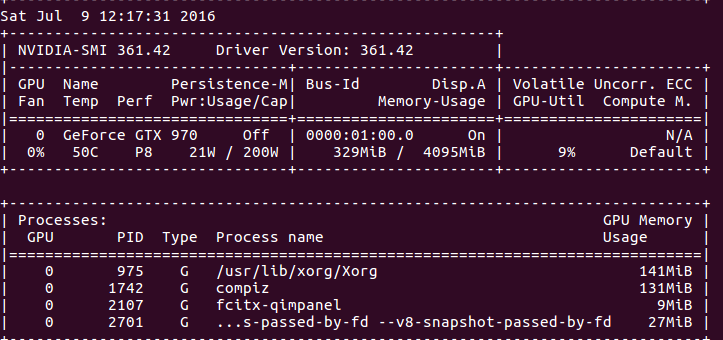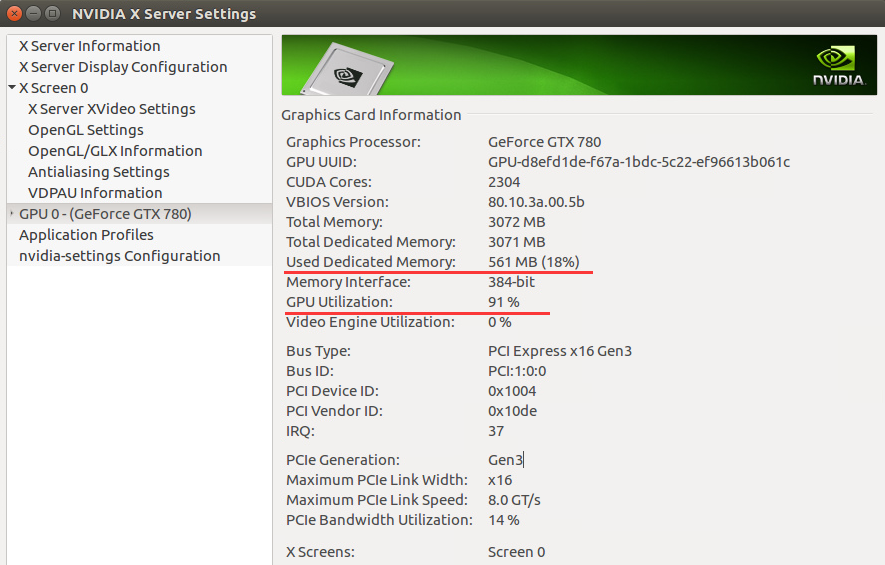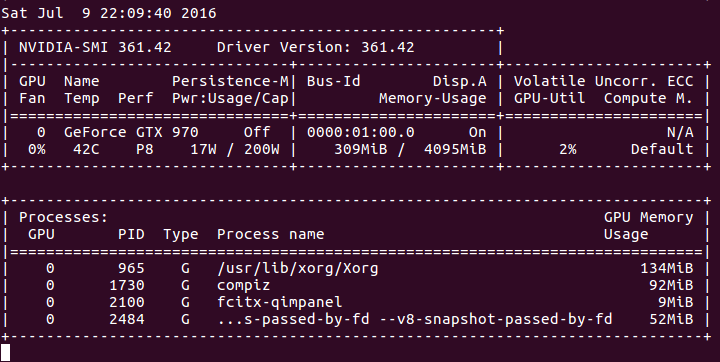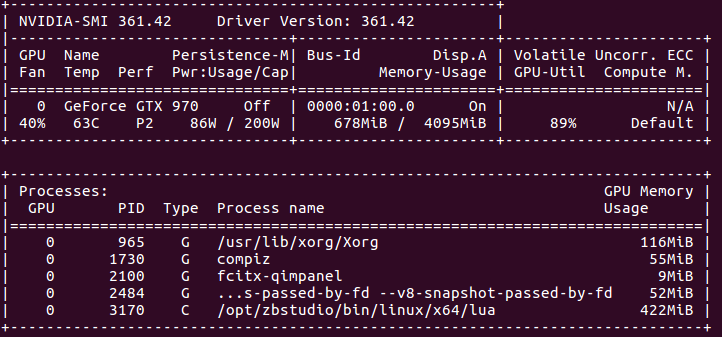(原)Ubuntu16中安装cuda toolkit
转载请注明出处:
http://www.cnblogs.com/darkknightzh/p/5655957.html
参考网址:
http://unix.stackexchange.com/questions/38560/gpu-usage-monitoring-cuda
http://blog.csdn.net/revolver/article/details/49682131
一 在终端中直接安装
说明:由于nvidia并未给出ubuntu16上面的cuda toolkit,本文方法不一定可行,我这边安装成功,感觉完全是瞎猫碰死耗子了。。。不过没有安装sample,只是其他程序可以使用显卡了。
1. 第一个网址,使用
sudo apt-get install nvidia-cuda-toolkit
安装cuda toolkit,要看网速,下载很慢。还有,网址中说重启ubuntu有问题(I can't log in to my computer and end up in infinite login screen)。我这边安装了之后,正常登陆了,没有出现问题。
2. 安装完之后的信息:
装的是7.5.17,不是最新的7.5.18,但是能用就行。

3. 第二个网址中qed给出了在终端中持续显示GPU当前的使用率(仅限nvidia的显卡):
nvidia-smi -l 1
结果:

说明:上面的命令貌似要显卡支持才行。也可以使用Jonathan提供的命令(目前没测试):
watch -n0. "nvidia-settings -q GPUUtilization -q useddedicatedgpumemory"
160713说明:a. 这条命令显示信息如下:

b. 其实这条命令就是在终端中显示‘NVIDIA X serve settings’中的一些信息,如下(NVIDIA X serve settings位置为/usr/share/applications,也可以直接打开该软件查看):

c. 由于这张图使用的GPU和之前使用的GPU不一样,因而参数不一致(比如显存)。
4. 安装完cuda之后,安装cutorch,之后安装cunn,都安装成功。使用GPU的程序也能正常运行。
5. 第三个参考网址中给出了测试程序,本处稍微进行了修改,打印出来每次循环执行的时间(CPU版本和GPU版本代码实际上差不多):
① CPU版本:
require 'torch'
require 'nn'
require 'optim'
--require 'cunn'
--require 'cutorch'
mnist = require 'mnist' fullset = mnist.traindataset()
testset = mnist.testdataset() trainset = {
size = ,
data = fullset.data[{{,}}]:double(),
label = fullset.label[{{,}}]
} validationset = {
size = ,
data = fullset.data[{{,}}]:double(),
label = fullset.label[{{,}}]
} trainset.data = trainset.data - trainset.data:mean()
validationset.data = validationset.data - validationset.data:mean() model = nn.Sequential()
model:add(nn.Reshape(, , ))
model:add(nn.MulConstant(/256.0*3.2))
model:add(nn.SpatialConvolutionMM(, , , , , , , ))
model:add(nn.SpatialMaxPooling(, , , , , ))
model:add(nn.SpatialConvolutionMM(, , , , , , , ))
model:add(nn.SpatialMaxPooling(, , , , , ))
model:add(nn.Reshape(**))
model:add(nn.Linear(**, ))
model:add(nn.ReLU())
model:add(nn.Linear(, ))
model:add(nn.LogSoftMax()) model = require('weight-init')(model, 'xavier') criterion = nn.ClassNLLCriterion() --model = model:cuda()
--criterion = criterion:cuda()
--trainset.data = trainset.data:cuda()
--trainset.label = trainset.label:cuda()
--validationset.data = validationset.data:cuda()
--validationset.label = validationset.label:cuda()--[[]] sgd_params = {
learningRate = 1e-2,
learningRateDecay = 1e-4,
weightDecay = 1e-3,
momentum = 1e-4
} x, dl_dx = model:getParameters() step = function(batch_size)
local current_loss =
local count =
local shuffle = torch.randperm(trainset.size)
batch_size = batch_size or
for t = ,trainset.size,batch_size do
-- setup inputs and targets for this mini-batch
local size = math.min(t + batch_size - , trainset.size) - t
local inputs = torch.Tensor(size, , )--:cuda()
local targets = torch.Tensor(size)--:cuda()
for i = ,size do
local input = trainset.data[shuffle[i+t]]
local target = trainset.label[shuffle[i+t]]
-- if target == 0 then target = 10 end
inputs[i] = input
targets[i] = target
end
targets:add()
local feval = function(x_new)
-- reset data
if x ~= x_new then x:copy(x_new) end
dl_dx:zero() -- perform mini-batch gradient descent
local loss = criterion:forward(model:forward(inputs), targets)
model:backward(inputs, criterion:backward(model.output, targets)) return loss, dl_dx
end _, fs = optim.sgd(feval, x, sgd_params) -- fs is a table containing value of the loss function
-- (just 1 value for the SGD optimization)
count = count +
current_loss = current_loss + fs[]
end -- normalize loss
return current_loss / count
end eval = function(dataset, batch_size)
local count =
batch_size = batch_size or for i = ,dataset.size,batch_size do
local size = math.min(i + batch_size - , dataset.size) - i
local inputs = dataset.data[{{i,i+size-}}]--:cuda()
local targets = dataset.label[{{i,i+size-}}]:long()--:cuda()
local outputs = model:forward(inputs)
local _, indices = torch.max(outputs, )
indices:add(-)
local guessed_right = indices:eq(targets):sum()
count = count + guessed_right
end return count / dataset.size
end max_iters = do
local last_accuracy =
local decreasing =
local threshold = -- how many deacreasing epochs we allow
for i = ,max_iters do
timer = torch.Timer() local loss = step()
print(string.format('Epoch: %d Current loss: %4f', i, loss))
local accuracy = eval(validationset)
print(string.format('Accuracy on the validation set: %4f', accuracy))
if accuracy < last_accuracy then
if decreasing > threshold then break end
decreasing = decreasing +
else
decreasing =
end
last_accuracy = accuracy print('Time elapsed: ' .. i .. 'iter: ' .. timer:time().real .. ' seconds')
end
end testset.data = testset.data:double()
eval(testset)
② GPU版本:
require 'torch'
require 'nn'
require 'optim'
require 'cunn'
require 'cutorch'
mnist = require 'mnist' fullset = mnist.traindataset()
testset = mnist.testdataset() trainset = {
size = ,
data = fullset.data[{{,}}]:double(),
label = fullset.label[{{,}}]
} validationset = {
size = ,
data = fullset.data[{{,}}]:double(),
label = fullset.label[{{,}}]
} trainset.data = trainset.data - trainset.data:mean()
validationset.data = validationset.data - validationset.data:mean() model = nn.Sequential()
model:add(nn.Reshape(, , ))
model:add(nn.MulConstant(/256.0*3.2))
model:add(nn.SpatialConvolutionMM(, , , , , , , ))
model:add(nn.SpatialMaxPooling(, , , , , ))
model:add(nn.SpatialConvolutionMM(, , , , , , , ))
model:add(nn.SpatialMaxPooling(, , , , , ))
model:add(nn.Reshape(**))
model:add(nn.Linear(**, ))
model:add(nn.ReLU())
model:add(nn.Linear(, ))
model:add(nn.LogSoftMax()) model = require('weight-init')(model, 'xavier') criterion = nn.ClassNLLCriterion() model = model:cuda()
criterion = criterion:cuda()
trainset.data = trainset.data:cuda()
trainset.label = trainset.label:cuda()
validationset.data = validationset.data:cuda()
validationset.label = validationset.label:cuda()--[[]] sgd_params = {
learningRate = 1e-2,
learningRateDecay = 1e-4,
weightDecay = 1e-3,
momentum = 1e-4
} x, dl_dx = model:getParameters() step = function(batch_size)
local current_loss =
local count =
local shuffle = torch.randperm(trainset.size)
batch_size = batch_size or
for t = ,trainset.size,batch_size do
-- setup inputs and targets for this mini-batch
local size = math.min(t + batch_size - , trainset.size) - t
local inputs = torch.Tensor(size, , ):cuda()
local targets = torch.Tensor(size):cuda()
for i = ,size do
local input = trainset.data[shuffle[i+t]]
local target = trainset.label[shuffle[i+t]]
-- if target == 0 then target = 10 end
inputs[i] = input
targets[i] = target
end
targets:add()
local feval = function(x_new)
-- reset data
if x ~= x_new then x:copy(x_new) end
dl_dx:zero() -- perform mini-batch gradient descent
local loss = criterion:forward(model:forward(inputs), targets)
model:backward(inputs, criterion:backward(model.output, targets)) return loss, dl_dx
end _, fs = optim.sgd(feval, x, sgd_params) -- fs is a table containing value of the loss function
-- (just 1 value for the SGD optimization)
count = count +
current_loss = current_loss + fs[]
end -- normalize loss
return current_loss / count
end eval = function(dataset, batch_size)
local count =
batch_size = batch_size or for i = ,dataset.size,batch_size do
local size = math.min(i + batch_size - , dataset.size) - i
local inputs = dataset.data[{{i,i+size-}}]:cuda()
local targets = dataset.label[{{i,i+size-}}]:long():cuda()
local outputs = model:forward(inputs)
local _, indices = torch.max(outputs, )
indices:add(-)
local guessed_right = indices:eq(targets):sum()
count = count + guessed_right
end return count / dataset.size
end max_iters = do
local last_accuracy =
local decreasing =
local threshold = -- how many deacreasing epochs we allow
for i = ,max_iters do
timer = torch.Timer() local loss = step()
print(string.format('Epoch: %d Current loss: %4f', i, loss))
local accuracy = eval(validationset)
print(string.format('Accuracy on the validation set: %4f', accuracy))
if accuracy < last_accuracy then
if decreasing > threshold then break end
decreasing = decreasing +
else
decreasing =
end
last_accuracy = accuracy print('Time elapsed: ' .. i .. 'iter: ' .. timer:time().real .. ' seconds')
end
end testset.data = testset.data:double()
eval(testset)
==================================================================================
17012更新:
今天重新试了一下上面的程序,提示下面的错误:
Epoch: 1 Current loss: 0.652170
/home/XXX/torch/install/bin/luajit: testGPU.lua:113: invalid arguments: CudaLongTensor CudaTensor
expected arguments: [*CudaByteTensor*] CudaLongTensor long | *CudaLongTensor* CudaLongTensor long | [*CudaByteTensor*] CudaLongTensor CudaLongTensor | *CudaLongTensor* CudaLongTensor CudaLongTensor
stack traceback:
[C]: in function 'eq'
testGPU.lua:113: in function 'eval'
testGPU.lua:131: in main chunk
[C]: in function 'dofile'
...gram/torch/install/lib/luarocks/rocks/trepl/scm-1/bin/th:150: in main chunk
[C]: at 0x00405d50
在GPU代码第113行加上下面一句话,就可以成功运行了:
indices=indices:cuda()
真是见鬼了。。。
170121更新结束
==================================================================================
6. CPU和GPU使用率
① CPU版本
CPU情况:

GPU情况:

② GPU版本
CPU情况:

GPU情况:

7. 可以看出,CPU版本的程序,CPU全部使用上了,GPU则基本没用。GPU版本,只有一个核心(线程)的CPU完全是用上了,其他的则在围观。。。而GPU使用率已经很高了。
8. 时间比较
CPU版本:
Epoch: Current loss: 0.619644
Accuracy on the validation set: 0.924800
Time elapsed: 1iter: 895.69850516319 seconds
Epoch: Current loss: 0.225129
Accuracy on the validation set: 0.949000
Time elapsed: 2iter: 914.15352702141 seconds
GPU版本:
Epoch: Current loss: 0.687380
Accuracy on the validation set: 0.925300
Time elapsed: 1iter: 14.031280994415 seconds
Epoch: Current loss: 0.231011
Accuracy on the validation set: 0.944000
Time elapsed: 2iter: 13.848378896713 seconds
Epoch: Current loss: 0.167991
Accuracy on the validation set: 0.959800
Time elapsed: 3iter: 14.071791887283 seconds
Epoch: Current loss: 0.135209
Accuracy on the validation set: 0.963700
Time elapsed: 4iter: 14.238609790802 seconds
Epoch: Current loss: 0.113471
Accuracy on the validation set: 0.966800
Time elapsed: 5iter: 14.328102111816 seconds
说明:① CPU为4790K@4.4GHZ(8线程全开时,应该没有这么高的主频,具体多少没注意);GPU为nvidia GTX 970。
② 由于CPU版本的执行时间实在太长,我都怀疑程序是否有问题了。。。但是看着CPU一直100%的全力工作,又不忍心暂停。直到第一次循环结束,用了将近900s,才意识到,原来程序应该木有错误。。。等第二次循环结束,就直接停止测试了。。。GPU版本的程序,每次循环则只用14s,时间上差距。。。额,使用CPU执行时间是GPU执行时间的64倍。。。
160727更新:
用了780和k80测试了一下,780要用18s迭代一次epoch,k80。。。额,迭代一次要23s(使用一个核心)。当然,只针对我这里的程序是这个结果,其他的,不太清楚。
============================================================================================
170121更新
使用笔记本的1060显卡测试了一下上面的程序,迭代一次用时10s(不保证其他条件完全一致,目前使用的是cuda8.0),不过即便是移动端的1060(虽说10系列移动端已经没有m标志了,但是参数和桌面版还是不完全一样),也还是比桌面版的970要强一点。
170121更新结束
============================================================================================
170505更新
重新配置了torch,使用1080Ti的显卡。但是测试上面的程序,迭代一次用时9s(不保证其他条件完全一致,目前使用的是cuda8.0)。理论上1080Ti比1060性能强一倍应该是有的,但是上面的程序迭代时,差距没有体现出来。累觉不爱。。。/(ㄒoㄒ)/~~
170505更新结束
============================================================================================
170613更新
使用tensorflow进行训练,同样的程序,迭代一次,k80单核要1.2s多,1080Ti要0.36s。性能差距体现出来了。之前性能差距无法体现出来的原因是,上面的测试程序过于简单(和程序有关,和torch及tensorflow无关。如果torch上复杂的程序,这两个卡性能差距也差不多这样),不能完全发挥1080Ti的性能(不清楚上面的程序,k80是否完全发挥出来了)。新的测试程序,1080Ti和K80的GPU utilization基本上都是在90%——100%,这种情况下,才能真正考验这两个显卡的性能差距。
170613更新结束
============================================================================================
二 在官网下载安装
170121更新
https://developer.nvidia.com/cuda-downloads中可以下载cuda。
1. 若下载deb文件
然后使用如下命令安装:
sudo dpkg -i cuda-repo-ubuntu1604---local_8.0.44-1_amd64.deb
sudo apt-get update
sudo apt-get install cuda
之后编辑.bashrc:
gedit .bashrc
输入:
export PATH=/usr/local/cuda-8.0/bin:$PATH
export LD_LIBRARY_PATH=/usr/local/cuda-8.0/bin/lib64:$LD_LIBRARY_PATH
之后终端中输入:
source ~/.bashrc
之后再输入:
nvcc --version

2. 若下载run文件
终端中输入:
sudo sh cuda_8.0.61_375.26_linux.run
之后按照说明安装即可(没用过这种方式,因而不确定是否需要添加PATH变量。如果不能识别nvcc,添加PATH变量之后,source ~/.bashrc即可)。
170121更新结束
============================================================================================
(原)Ubuntu16中安装cuda toolkit的更多相关文章
- Anaconda--在虚拟环境中安装CUDA and cudnn
在conda虚拟环境中安装CUDAconda install cudatoolkit=8.0 -c https://mirrors.tuna.tsinghua.edu.cn/anaconda/pkgs ...
- (原)ubuntu16中安装moses
转载请注明出处: http://www.cnblogs.com/darkknightzh/p/5653186.html 在ubuntu14中,可以使用下面的语句安装moses: luarocks in ...
- (原)Ubuntu16中安装nvidia的显卡驱动
转载请注明出处: http://www.cnblogs.com/darkknightzh/p/5638185.html part1 直接在“软件和更新-附加驱动”里面设置 安装完ubuntu16后,显 ...
- Ubuntu18.04中安装cuda的记录
一.参考: https://blog.csdn.net/QLULIBIN/article/details/78714596 https://www.jianshu.com/p/00c37b09f0f3 ...
- OpenSuse13.2安装CUDA Toolkit 7.5
此次安装过程有点曲折,不过最后还是能成功安装,由于没细细看官方的安装文档,导致花了很多时间安装,希望此文能让想装CUDA的同学少走点弯路 1.NVIDIA Driver是否要装 刚开始要装CUDA时, ...
- (原)Ubuntu16 中安装torch版的cudnn
转载请注明出处: http://www.cnblogs.com/darkknightzh/p/5668471.html 参考网址: https://devtalk.nvidia.com/default ...
- (原)ubuntu14及ubuntu16中安装docker
转载请注明出处: http://www.cnblogs.com/darkknightzh/p/5653739.html 参考网址: http://blog.csdn.net/yangzhenping/ ...
- (原+转)ubuntu16中安装opencv2.4.11
转载请注明出处: http://www.cnblogs.com/darkknightzh/p/5638117.html 参考网址: http://www.cnblogs.com/jeakon/arch ...
- (原+转)ubuntu16中安装opencv2.4.11(2.4.13)
转载请注明出处: http://www.cnblogs.com/darkknightzh/p/5638117.html 参考网址: http://www.cnblogs.com/jeakon/arch ...
随机推荐
- cocos2dx 字体描边方法介绍
转载地址:http://www.taikr.com/group/2/thread/1606 关于cocos2dx 字体描边的实现,不考虑效果和效率的话,是有三种方式: ① 利用CCLabelTTF制作 ...
- php代码-1
- Lambda表达式 之 C#
Lambda表达式 "Lambda表达式"是一个匿名函数,是一种高效的类似于函数式编程的表达式,Lambda简化了开发中需要编写的代码量.它可以包含表达式和语句,并且可用于创建委托 ...
- 给div中动态添加节点并设置样式
前端IOS今天需要动态的在图片前面添加一个按钮 主要是在使用 bt.setAttribute("class","aaa"); 可以对创建的节点使用setAttr ...
- php缓存技术常用函数
OB缓存系列函数(输出缓存) ob_start()函数:打开输出缓冲区. 函数格式 ob_start(void) 说明:当缓冲区激活时,所有来自PHP程序的非文件头信息均不会发送,而是保存在ob缓冲区 ...
- BZOJ 1502 月下柠檬树(simpson积分)
题目链接:http://61.187.179.132/JudgeOnline/problem.php?id=1502 题意:给出如下一棵分层的树,给出每层的高度和每个面的半径.光线是平行的,与地面夹角 ...
- LeetCode_Triangle
Given a triangle, find the minimum path sum from top to bottom. Each step you may move to adjacent n ...
- PHP mail详细示例
From:http://php.net/manual/zh/function.mail.php Example #1 Sending mail. Using mail() to send a simp ...
- SOCKET 实现NAT 穿越
在当前IPv4NAT盛行的网络环境下,两个用户要直接进行P2P连接是非常困难的.较好的解决办法是借助含公网的用户或是服务器中介实现P2P连接. NAT:Network Address Translat ...
- mysql用户和权限管理
用户和权限管理 Information about account privileges is stored in the user, db, host, tables_priv, columns_p ...
